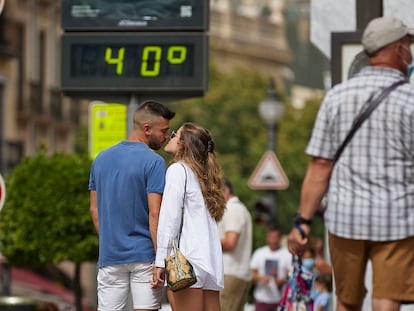The climate refugees in Madrid’s shopping malls: ‘They stay there all day because it’s cool’
Centers in wealthy areas of the Spanish capital have not seen the same rise in numbers, with residents preferring to cool off in their private swimming pools
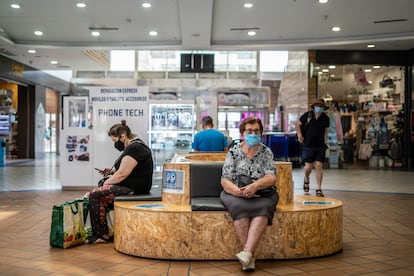

Whether shopping malls act as refuges from the heat depends on the purchasing power of the neighborhood, as reflected by two centers in the east of Madrid separated by only 1.8 kilometers: Alcalá Norte and Arturo Soria Plaza.
The first is surrounded by blocks of apartments filled with migrants renting by the room, mostly without air conditioning; the second backs onto villas worth up to €7 million, where politicians, businessmen and celebrities have swimming pools and large gardens.
In the Alcalá Norte shopping center, Bolivia-born jewelry salesman Daniel Seoane says that more customers do come in on hot days. He has even made a calculation: “It goes up 20%,” he says. From his stall in one of the aisles, he is able to watch the public as they enter, clearly overwhelmed by the heat. This week temperatures in Madrid are up around 40 degrees Celsius due to a heatwave that is sweeping across the country. Those who have an air conditioner unit at home resist turning it on as electricity prices are soaring along with the temperatures.
Those cooling off in the Alcalá Norte mall come predominantly from the Pueblo Nuevo neighborhood, like Peruvian cleaner Melissa Salazar, who lives four blocks away, and has hurried in to get away from the heat, carrying an old Powerade bottle filled with water. Her other hand holds that of her seven-year-old daughter, Alondra. “We were in the park and came in for a while to get some fresh air,” she says. “We come in two or three times a week.” Alondra wears a t-shirt emblazoned with a picture of Elsa, the heroine of the cartoon movie Frozen, who has the ability to freeze everything she touches.
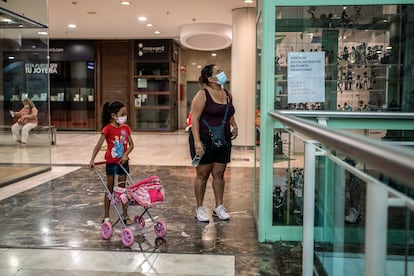
But Alcalá Norte is not exactly an ice kingdom. The temperature is certainly cooler than outside, but shopping malls in working-class areas also have to economize. At times, no air comes out of the grille that is located next to Seoane’s stall. “A couple of days ago, I was dripping sweat from my forehead like it was the Iguazú Falls,” he says. “I looked for the maintenance man and asked him to turn on the air, but he told me that the boss won’t let them.”
The mall on the other side of the tracks is a different story altogether. In Arturo Soria Plaza, the problem is not the electricity bill, according to the management. The problem is that the residents of the Conde Orgaz apartments spend their days in their private swimming pools. They appear very early at Sánchez Romero, Spain’s most expensive supermarket, and do not reappear until dusk.
It’s been two hours since anyone rolled up to Clara Ramírez’s newsstand, which is not normal because it is Wednesday. “Today is the day Hola! magazine comes out and there should be more people around here,” she says. Many sales assistants stand idly by their counters. Melanie Leao, at the Hawker eyewear store, is not surprised that the locals are immersed in their private pools. That’s what she did as a child in the small town of Colmenar de Oreja. Now she lives in an apartment in Ensanche de Vallecas and on her afternoons off, she likes to go to one of the nearby malls with friends, such as La Gavia or Parquesur. “If you go there now, they are full!” she says.
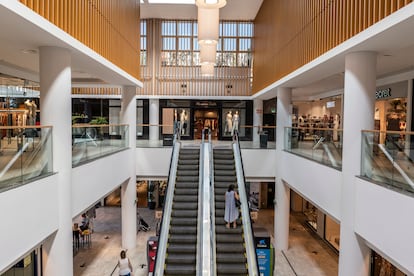
August is always a bad month for business in Madrid because the city is half-empty as residents leave for summer vacations. Traffic picks up only slightly on the hottest days. There are counters at the entrance that count the numbers coming in and they are aware when people are coming just to escape the heat; they see them wandering the aisles, without shopping bags, and spending three hours sitting in a café with a Coke.
“It’s one thing to have 30 more people in your center and another to have them buy,” says Verónica Saldaña, a shopping mall consultant who has worked for Alcalá Norte. “You can see that the influx is not reflected by the sales.”
Numbers have almost doubled in Madrid’s blue-collar malls compared to the affluent centers during this week’s heatwave. On Wednesday, when temperatures reached 38ºC, lower-middle-income areas saw an 8.3% increase in visitors compared to Tuesday when the maximum temperature was 36ºC, while upper-middle-income areas saw a more modest rise of 4.7%, according to consultancy Cad&Lan, which has data on 120 shopping malls in Spain.
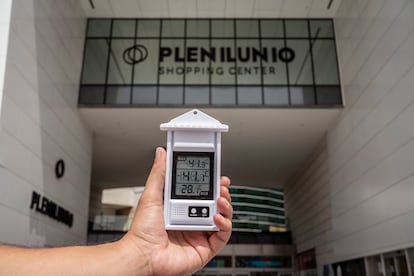
The data that is of interest to the stores is the conversion of visits into sales. As those simply seeking refuge from the heat consume little, some shopping centers are careful not to advertise cool temperatures on their premises. The assistant manager of La Vaguada shopping mall, Jesús Hernández, recalls that years ago when he worked in the Islazul shopping center, in Carabanchel, the approach was very direct: “It’s 25ºC here; outside, it’s 39ºC.”
Carrefour supermarket marathon
Temperature, music and light are all vital to a mall. Everything is gauged in order to encourage the consumer to buy. Excessive cold is inadvisable. Some studies have found that customers in a warm room buy more than in a cold room because it improves their perception of the products. Nor do you want to strip off in a fitting room only to find you’re freezing to death. “People complain about the cold,” says Yolanda, the manager of the Mango clothing store at Plenilunio shopping center. “They say, ‘Hey, I’m freezing,’ and meanwhile we are pouring with sweat because we’re moving around.”
In any case, legislation has prohibited shopping malls from putting the air conditioning up too high for energy-saving reasons. In 2009, a law was passed stating that air conditioning in public facilities cannot go below 26ºC; in winter, heating in public spaces cannot go above 21ºC.
EL PAÍS tested the temperature of several shopping centers with two portable thermometers, only to find the temperature to be above 30ºC. On the second floor of Plenilunio mall, where the food court is located, it rose to 31ºC on Wednesday at lunchtime.
But it is still cooler walking through a shopping center than fanning yourself in the living room.
Some traders in the Alcalá Norte center harbor doubts that the locals in Pueblo Nuevo hang out in the malls to get away from the heat. “No one comes because no one goes out,” says Eva Díez, owner of the gift store, Unicornis.
But the locals themselves in working-class neighborhoods recognize the phenomenon as a reality. “I have neighbors who go to the Carrefour supermarket and stay there all day because it’s cool and there are benches,” says Miguel Pérez, a resident of Las Rosas. Meanwhile, Noni González is having a beer while waiting for lunch. “Do people come because of the heat? Of course, they do. I’m 100% sure that’s why so many people come here.”
English version by Heather Galloway.
Tu suscripción se está usando en otro dispositivo
¿Quieres añadir otro usuario a tu suscripción?
Si continúas leyendo en este dispositivo, no se podrá leer en el otro.
FlechaTu suscripción se está usando en otro dispositivo y solo puedes acceder a EL PAÍS desde un dispositivo a la vez.
Si quieres compartir tu cuenta, cambia tu suscripción a la modalidad Premium, así podrás añadir otro usuario. Cada uno accederá con su propia cuenta de email, lo que os permitirá personalizar vuestra experiencia en EL PAÍS.
¿Tienes una suscripción de empresa? Accede aquí para contratar más cuentas.
En el caso de no saber quién está usando tu cuenta, te recomendamos cambiar tu contraseña aquí.
Si decides continuar compartiendo tu cuenta, este mensaje se mostrará en tu dispositivo y en el de la otra persona que está usando tu cuenta de forma indefinida, afectando a tu experiencia de lectura. Puedes consultar aquí los términos y condiciones de la suscripción digital.
More information
Últimas noticias
Most viewed
- Sinaloa Cartel war is taking its toll on Los Chapitos
- Oona Chaplin: ‘I told James Cameron that I was living in a treehouse and starting a permaculture project with a friend’
- Reinhard Genzel, Nobel laureate in physics: ‘One-minute videos will never give you the truth’
- Why the price of coffee has skyrocketed: from Brazilian plantations to specialty coffee houses
- Silver prices are going crazy: This is what’s fueling the rally

